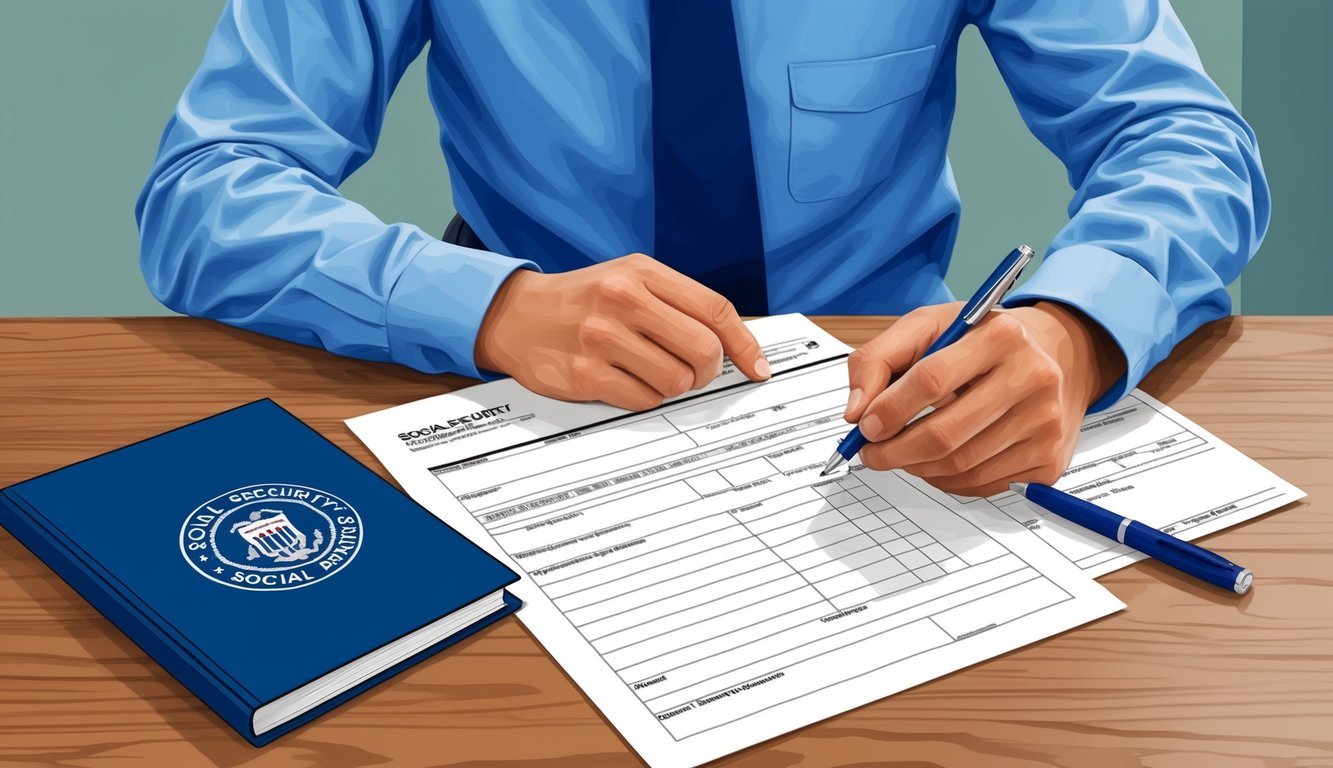Thinking About Applying for Social Security Disability?
Are you considering signing up for Social Security Disability? You’re definitely not alone.
Many folks out there are dealing with health issues that keep them from working.
The good news? Applying for disability benefits isn’t as complicated as it might seem at first glance.

Ready to take the first step? First, gather some important info: your medical records, work history, and personal details.
With everything in hand, you can apply online, call in, or visit your local Social Security office.
It may take a bit of time, but if you qualify, the support can really make a difference.
Just a heads-up—patience is super important when applying for Social Security Disability.
Getting a decision on your application can take months, but while you wait, focus on taking care of yourself and staying positive.
Your journey toward getting help is just beginning!
Key Takeaways
- You can apply for disability benefits online, by phone, or in person.
- Gather your medical records and work history before applying.
- Be patient; the decision process may take several months.
Eligibility and Application
Applying for Social Security Disability can seem a bit tricky, but if you know the steps, it’s completely doable.
Let’s break down how to qualify and sign up for those much-needed disability benefits.
Understanding SSDI and SSI
Social Security has two main programs when it comes to disability: Social Security Disability Insurance (SSDI) and Supplemental Security Income (SSI).
SSDI is for those who have worked and paid into Social Security.
On the flip side, SSI is designed to help people with limited income and resources.
If you’re aiming for SSDI, you’ll need a certain number of work credits—these come from jobs where you’ve paid Social Security taxes.
The number of credits you need depends on your age when you became disabled.
SSI doesn’t require a work history, but you must have low income and resources.
Plus, you need to be disabled, blind, or 65 or older.
Both SSDI and SSI share the same definition of disability: a condition that prevents you from working for at least a year or is expected to result in death.
Qualifying Medical Conditions
Social Security has a list of medical conditions that may qualify you for disability benefits.
These include:
- Back problems
- Heart issues
- Lung diseases
- Mental disorders
- Immune system disorders
Your condition doesn’t have to be on this list to qualify.
It’s all about how it affects your ability to work.
When you apply, Social Security will review your medical records to see if your condition is severe enough.
You’ll need to provide detailed info about your medical history, including doctors’ reports, tests, and treatments.
Preparing to Apply
Before you jump into the application process, gather everything you’ll need.
It makes the whole thing much smoother.
Here’s a quick checklist:
- Your Social Security number
- Birth certificate
- Medical records from all your doctors
- Lab and test results
- A list of medications
- A summary of your work history
Social Security offers a handy Disability Starter Kit that has worksheets and checklists to guide you.
If you’re applying for a child, don’t forget to include their school records.
Think about how the disability affects daily life.
Be ready to share that info in detail.
How to Apply
You can apply for disability benefits in three easy ways:
- Online at the Social Security website.
- By phone at 1-800-772-1213.
- In person at your local Social Security office.
Going online is usually the easiest option.
You can take your time and save your progress as you go.
When you fill out your application, be honest and provide detailed answers.
After you submit, Social Security might reach out for more info.
Just a heads up: the review process can take a few months.
They’ll go over your application and medical evidence, and they might send you for a free medical exam if needed.
If you’re denied, don’t lose hope! You can appeal the decision, and many people get approved on their appeal.
What Happens After You Apply?

Once you submit your application, a series of reviews, possible medical exams, and decisions about your eligibility start.
Staying informed is key!
What to Expect Next
After sending in your application, the Social Security Administration will review it.
They’ll check if you meet the basic requirements for benefits.
If you do, they’ll forward your case to a Disability Determination Services office in your area.
This office will dive into your medical records.
They might ask your doctors for more details about your condition or even request that you get a special medical exam.
Don’t worry; they’ll cover the cost!
The review usually takes around 3 to 5 months.
If you’re curious about your application status, you can check online or give Social Security a call.
If they need more info, they’ll reach out.
Make sure to respond quickly—no one likes delays, right?
Managing Your Benefits
If your claim is approved, you’ll start receiving benefits after a 5-month waiting period.
This starts from the first full month after Social Security decides when your disability began.
You’ll get a letter that outlines how much you’ll receive each month.
This amount depends on your average earnings over time.
You might even get back pay—money for the time you were disabled before your application was approved.
Be sure to keep Social Security updated about any changes in your condition or work status.
If you start working again, even part-time, let them know right away.
You can manage your benefits online through your my Social Security account.
Here, you can update your info, check payment dates, and obtain benefit verification letters.
Need Some Extra Support?
While you’re waiting for a decision, you may need extra help.
The Supplemental Security Income (SSI) program can provide funds to help with basic needs if you have limited income and resources.
Your family might also be eligible for benefits based on your work record.
This includes your spouse and children under 18.
If you’re denied benefits, don’t throw in the towel! You can appeal the decision, and you have 60 days from when you get the denial letter.
This can be done online, by phone, or at your local Social Security office.
For more assistance, call the Social Security toll-free number at 1-800-772-1213.
If you’re deaf or hard of hearing, use the TTY number.
FAQs About Social Security Disability
Applying for Social Security Disability can raise a lot of questions.
Let’s tackle some common ones to help you feel more at ease.
What documents do I need to apply for Social Security Disability?
You’ll need to get a few important papers together.
This includes your birth certificate, Social Security card, and medical records.
Don’t forget those W-2 forms or last year’s tax returns!
Also, have a list of your medications handy and the contact info for your doctors.
This info helps show your health issues.
How do I start my application for Social Security Disability benefits?
It’s super easy to apply online for disability benefits.
You can do it from the comfort of your own home.
If you’d rather chat with a person, call 1-800-772-1213 to schedule an appointment.
A representative can guide you step-by-step and answer any questions you have.
If you’re curious about short-term disability, check with your employer or insurance provider to see what you need.
Knowing your options is key during tough times.
Of course, you can also visit your local Social Security office to apply in person.
Choose whichever method works best for you!
Which medical conditions are typically approved for disability benefits?
A lot of health problems can qualify you for benefits.
Common examples include heart disease, severe arthritis, and mental health issues like depression.
You might also see conditions like cancer, multiple sclerosis, and severe back pain on the list.
Just remember—it’s not only about the diagnosis.
It’s about how much the condition impacts your daily activities.
Can doctors fill out Social Security Disability forms online?
Your doctors can’t complete your entire application online, but they can submit medical evidence electronically.
This can help speed up the process.
Ask your doctor to send your medical records to Social Security.
They might have a secure online system for this.
Is there a fast-track process for obtaining disability benefits?
Yes! There’s a fast-track option called Compassionate Allowances.
This is for very serious conditions that clearly meet disability standards.
Some examples are certain cancers, ALS, and early-onset Alzheimer’s. If you have one of these, your claim might be approved in just weeks instead of months.
How is the monthly payment for Social Security Disability determined?
Your payment amount depends on your work history.
Social Security looks at how much you’ve earned over the years and what you’ve paid in taxes.
The average payment in 2022 was around $1,358 per month.
But remember, it can vary based on your specific situation.
The max you could receive is about $3,300 a month.

